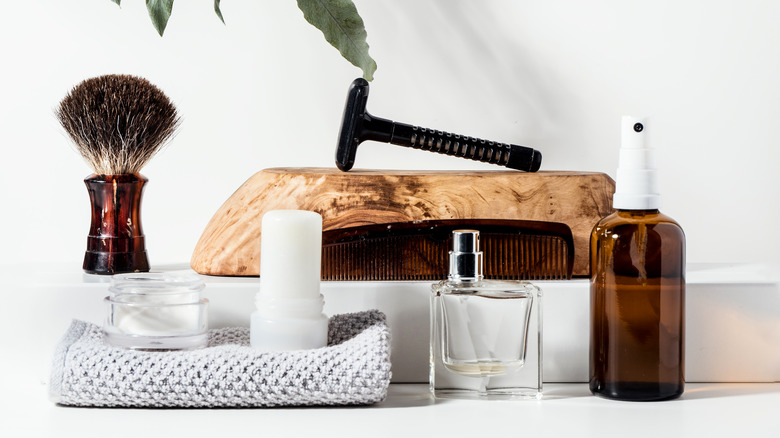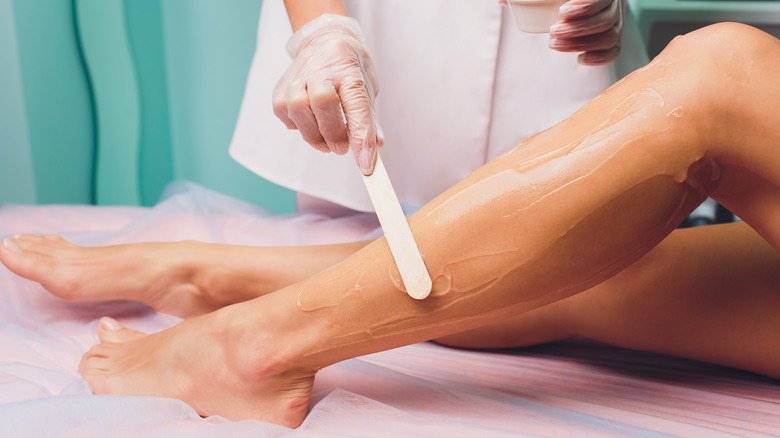Bikini Wax Vs. Shaving: What Is Best For Your Skin?
We may receive a commission on purchases made from links.
When it comes to hair removal techniques, the list is long and includes options for every need and budget. Shaving, which can include a variety of mistakes and slip-ups (it's not easy to perform a balancing act in the shower), is one of the most accessible choices because it only requires a razor and shaving cream. Other options, such as laser hair removal, require professional technicians and special equipment. Waxing is another popular method to get those follicles out, and there are many budget-friendly at-home kits to pick up when visiting salons become too expensive.
Besides the accessibility of each hair removal method, the quality of the results and the process itself are other factors to take into consideration. While shaving is a quick and simple procedure, there are a lot of questions. Should you exfoliate the area before or after shaving? What razor is the most effective? How long do the results last? According to the Cleveland Clinic, the results may only last for a couple of days. On the other hand, waxing can leave you with results lasting up to a month. However, are you willing to endure the pain the process comes with? The pros and cons list is just as long as the process of deliberation. If you're having trouble choosing between shaving or waxing the bikini line, we've done the research so you don't have to.
Waxing leaves you with lasting results
By definition, waxing is a grueling process where your hair is pulled from its roots with a waxy substance that attaches itself to it. But after a quick fifteen minutes of pain, your skin is left hairless and smooth. Shaving also takes just as long and leaves you with similar results. It's also easier to pick up a razor and shaving gel than work with wax strips or heated wax, which are more effective when used with skill. However, your results may last for different times. You'd only be revisiting the at-home wax kit (or professional) after a month while your razor might make an appearance in your shower routine in just a few days.
According to the Cleveland Clinic, results can last for up to four weeks when waxing, depending on your hair growth and skin. "Because the hair comes out by the root, it grows back in much slower than shaving, so you stay nice and smooth longer," New York-based dermatologist Angela Lamb told Elle. Shaving only chops the hair off the surface of your skin, which is why it can be better suited as an immediate but temporary method of hair removal.
Shaving might be better for sensitive skin
The bikini line isn't known for its endurance, and one of the main draws of waxing is definitely not the inescapable pain you have to go through during the process. "Waxing means truly ripping hairs out by their roots, and we all know or have heard that this is quite a painful process," Jessica Krant, M.D. told Bustle. "It hurts for only one reason: The hairs really are attached very firmly to their roots and are a part of our body. Pulling them out means tearing them out by the root. It leaves a tiny wound just under the surface." So, it's common to have reddened, irritated skin after waxing, which is why loose clothes are best for appointments.
This can be exacerbated for those with sensitive skin, which means shaving might be a better idea. However, that doesn't mean that you can't irritate your skin with shaving which is a method notorious for giving ingrown hairs. "Ingrown hairs are formed when the sharp, freshly shaved hairs, puncture and grow into the surrounding skin," Ife J. Rodney, M.D. told Women's Health. "To prevent rashes and irritation, you should only shave with a clean, sharp razor." Dermatologist Marie Hayag also suggested looking for a razor with five closely-spaced blades as "[It] prevents the skin from bulging up in-between the blades for a more comfortable shave on sensitive skin," (via Allure).
You may need to see a professional for waxing
Clearly, waxing is more complicated than shaving. There are many waxes to choose from; hard, soft, chocolate, and sugar wax are just a few options. You also have to pay attention to the direction of hair growth, the amount of wax you're applying to your skin, and the force with which you rip your hair out. Your hair also has to be of a certain length for waxing to work: "The hair should be between an eighth- and a quarter-inch long," aesthetician Hannah Naranjo told Allure. Add to that: the sensitivity of the bikini line.
For that reason, most dermatologists advise against using at-home waxing kits. "There are many variables that can go awry with waxing at home, including managing the temperature of the wax, which requires heating, waxing off just the hair (and not the skin), and irritated reactions to components of the kits," board-certified dermatologist Chris G. Adigun told Allure. A professional would manage all of these elements while making waxing a comfortable experience for you. However, regular visits can significantly up your monthly expenses.
Shaving is more budget-friendly
Compared to the cost of paying a waxing specialist every month, investing in a good razor is really the only cost you need to bear while shaving. The average razor sitting in your local drugstore will not set you back by much; these razors from Gillette only cost a little over $6. A shaving gel (like this delicious one from Amazon) and good technique is all you need to have a smooth shaving experience.
However, the fact that you'd need to shave more than you'd wax means that investing in a good razor (and replacing blades) can make all the difference for your skin. "Shave in single strokes in the direction of hair growth, cleaning the razor between strokes," dermatologist Joshua Zeichner told mindbodygreen. "If you feel any tugging on the skin, it means that the blades are getting dull and they should be switched out."
But even with regular replacement blades, shaving is cheaper than waxing. According to Healthline, you can pay an average of $50 to $70 for one waxing appointment, which you're likely to make every month. However, you'd pay only for a good razor and replacement blades which can cost anywhere between $5 to $20 (an electric one might cost more) while shaving.
Waxing leaves your skin exfoliated
Your exfoliation routine can change significantly based on what method of hair removal you choose as well. Unlike shaving, waxing can exfoliate your skin. "Waxing can actually simultaneously remove some of the top layers of dead skin cells, which can make your skin feel smoother," dermatologist Angela Lamb told Elle. This means that you should "exfoliate regularly and before waxing, but not immediately before waxing," dermatologist Hadley King told mindbodygreen. "You want the skin barrier to be intact to minimize risk of burning or irritation from waxing."
For shaving, "gentle exfoliation can help [loosen] the free edge of hairs that may be trapped under the skin," board-certified dermatologist Joshua Zeichner told the publication. "This can give you a smoother shave and lower the likelihood of razor bumps or irritation."
In short, both methods are effective in hair removal and have pros as well as cons. Waxing can exfoliate your skin, remove hair from its root, and keep your skin smooth for longer than shaving. If you don't have sensitive skin, it may actually be the best for your skin. However, it can be an expensive affair. Shaving is convenient and cost-effective but the results fade away too soon. If you're still unsure, speak to your dermatologist or an esthetician to help you make a decision that's right for your skin type.





